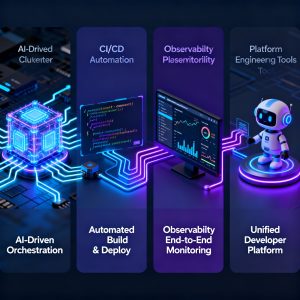The Global Scale of Netflix Streaming
Netflix has become synonymous with online video streaming, serving over 300 million subscribers in 190 countries. The platform is responsible for approximately 15% of global downstream internet traffic and sees users stream more than 94 billion hours of content in just six months. With peak usage sometimes consuming up to 15% of worldwide internet bandwidth, the technical demands on Netflix’s infrastructure are immense.
Dual-Cloud Approach: Control Plane and Data Plane
Netflix’s architecture is fundamentally divided into two specialized cloud systems:
- Control Plane (AWS): All user interactions before playback—browsing, recommendations, and account management—are handled by microservices running on Amazon Web Services.
- Data Plane (Open Connect): Once a title is selected, Netflix’s proprietary Content Delivery Network, Open Connect, takes over to stream video efficiently.
This separation allows Netflix to optimize each system for its unique requirements: transactional consistency and high availability for the control plane, and high throughput with edge distribution for the data plane.
The Evolution from Monolith to Microservices
Originally, Netflix operated using traditional data centers and monolithic applications. A major outage in 2008, caused by database corruption, led to a strategic migration to AWS and a complete architectural overhaul. Over eight years, Netflix transitioned to a microservices-based system, enabling horizontal scaling and improved reliability.
Microservices: The Backbone of Netflix’s User Experience
When users open Netflix, they interact with hundreds of independent microservices, each responsible for a specific function:
- Authentication: Verifies user identity.
- User Profile: Manages preferences and watch history.
- Content Service: Supplies metadata for shows and movies.
- Recommendation Engine: Suggests content based on viewing patterns.
- Search Service: Enables fast catalog queries.
These services communicate through APIs, ensuring that failures in one area do not cascade across the platform. This loosely coupled architecture allows for rapid deployment and fault isolation.
Orchestration and Service Management
Managing hundreds of microservices requires sophisticated orchestration. Netflix employs:
- API Gateway (Zuul): Routes requests and handles authentication.
- Service Discovery (Eureka): Registers and monitors service health.
- Client-Side Load Balancing (Ribbon): Distributes traffic to healthy instances.
- Circuit Breaker (Hystrix): Prevents cascading failures.
This infrastructure enables Netflix to deploy updates hundreds of times per day without disrupting the user experience. Many of these tools have been open-sourced, influencing industry standards for distributed systems.
Polyglot Persistence: Tailored Data Storage
Netflix’s data architecture leverages multiple database technologies, each chosen for specific workloads:
- Cassandra: Stores user profiles and preferences.
- EVCache: Caches frequently accessed data for speed.
- MySQL/RDS: Manages transactional data with strong consistency.
- Amazon S3: Houses vast video libraries and analytics data.
This polyglot approach ensures optimal performance and scalability, powering Netflix’s personalized recommendations and user experiences.
The Critical Handoff: Pressing Play
When a user selects a title, the system rapidly:
- Assesses device and network conditions.
- Requests authorization from the control plane.
- Selects the optimal Open Connect server based on proximity, health, content, and load.
- Provides secure URLs for video access.
- Initiates streaming using adaptive bitrate protocols.
This seamless transition between control and data planes is key to Netflix’s smooth playback.
Open Connect: Netflix’s Custom CDN
Netflix built Open Connect, its own content delivery network, to optimize video streaming. The CDN uses a two-tier architecture:
- Storage Appliances: Located at internet exchange points, holding nearly the entire Netflix catalog.
- Edge Appliances: Placed within ISP networks, caching regionally popular content.
By deploying hardware within ISPs, Netflix minimizes internet transit, reduces latency, and improves streaming quality. Predictive caching ensures high hit rates and efficient content delivery.
Adaptive Streaming and Content Preparation
Before reaching viewers, all content is processed through a sophisticated encoding pipeline. Netflix analyzes each title and applies per-title encoding optimization, generating multiple quality levels and formats. This reduces bandwidth usage by up to 40% without sacrificing visual quality.
Content is then segmented for adaptive bitrate streaming. The client app monitors bandwidth and buffer status in real time, dynamically adjusting quality to avoid interruptions.
Engineering for Resilience
Netflix’s architecture is designed to expect and withstand failures. Key resilience patterns include:
- Circuit Breakers: Isolate failing services.
- Fallbacks: Provide degraded but functional responses.
- Bulkheads: Prevent failures from spreading.
- Timeouts: Avoid resource exhaustion from slow services.
Netflix pioneered chaos engineering with tools like Chaos Monkey, which randomly disables instances to ensure the system can recover from unexpected failures. This approach has made Netflix a model for resilience in distributed systems.
Data-Driven Continuous Improvement
Every interaction on Netflix generates telemetry data, feeding into a powerful analytics pipeline. Real-time and batch processing frameworks analyze performance, detect issues, and inform improvements to recommendation algorithms and infrastructure. An extensive experimentation platform enables thousands of A/B tests, ensuring only beneficial changes are fully rolled out.
Continuous Deployment at Scale
Netflix’s deployment pipeline supports thousands of updates daily through:
- Immutable Infrastructure: Deploying pre-packaged application images.
- Blue/Green Deployments: Running new and old versions side by side.
- Canary Analysis: Gradually exposing new features to detect issues.
- Automated Rollbacks: Quickly reverting problematic updates.
Tools like Spinnaker automate testing and rollouts, while feature flags allow controlled releases.
Addressing Live Streaming Challenges
While Netflix’s architecture excels at on-demand streaming, live events present new challenges. The 2024 Tyson-Paul boxing match, with 65 million concurrent viewers, exposed limitations in live content delivery, such as real-time encoding, manifest management, and CDN caching. However, the platform’s microservices design ensured that issues with live streaming did not affect on-demand services.
Key Takeaways for Software Engineers
Netflix’s architecture demonstrates the value of:
- Vertical integration for end-to-end optimization.
- Microservices for scalability and fault isolation.
- Custom CDN solutions for performance.
- Resilience engineering and chaos testing.
- Data-driven decision making and continuous deployment.
Netflix’s Technology Stack at a Glance
| Layer | Technologies & Tools |
|---|---|
| Frontend | React, Node.js, Redux, JavaScript, Swift, Kotlin |
| Backend | Java, Spring Boot, Python, GraphQL |
| Data | Cassandra, MySQL/RDS, CockroachDB, EVCache, S3 |
| Analytics | Apache Kafka, Flink, Spark, Tableau |
| DevOps & Security | Jenkins, Spinnaker, Chaos Monkey, Prometheus, Grafana |
| Machine Learning | SageMaker, TensorFlow |
Conclusion
Netflix’s journey from a DVD rental service to a global streaming powerhouse is a testament to the power of innovative system architecture. By embracing microservices, building a custom CDN, and prioritizing resilience and data-driven improvement, Netflix delivers high-quality video to millions worldwide—making seamless streaming the norm, not the exception.
Read more such articles from our Newsletter here.



